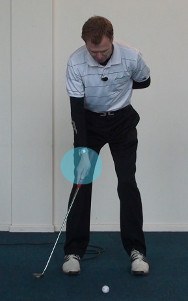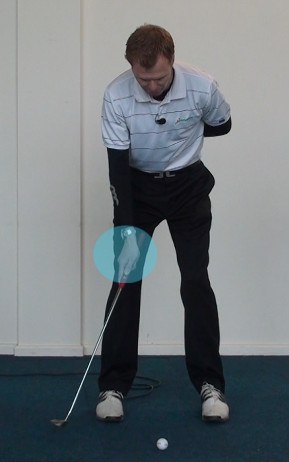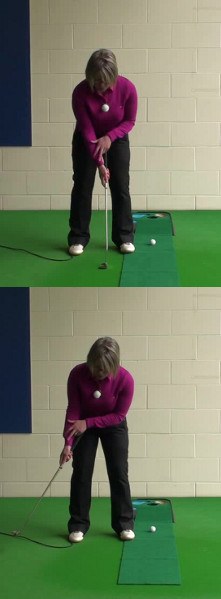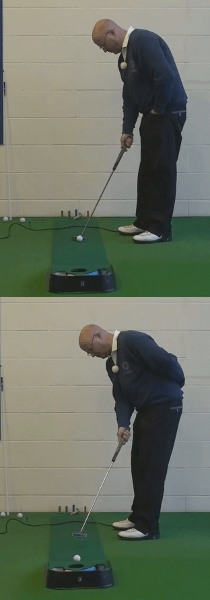
Decades ago, pro golfers used a wristy, popping action when putting to get the ball rolling on slow, bumpy greens. Modern maintenance equipment makes for smoother putting surfaces – which call for a stroke to match.
Golf teachers advocate a putting motion controlled by the arms and shoulders, as opposed to the wrists and hands. Too much small-muscle involvement leads to inconsistent contact and putts that skitter past the cup.
The “one-arm putting drill” is a great practice aid for smoothing out your stroke. Start by hitting a series of short putts (3 feet or so) with only your right arm. Once you've got a feel for the stroke, move a few feet farther away, and continue until you're at least 15 feet from the hole.
Repeat the process with the left arm.
Using just one arm makes it difficult to involve the wrist, encouraging the arm and shoulder to engage and work in tandem. The goal is a pendulum-like motion without interference from the hands. This one-arm putting drill also improves feel and touch.
Become adept at hitting solid, one-handed putts and the two-handed variety will be a breeze.
Thomas Golf Putters
Traditional, Mid-Length/Belly & Long Putters

One Arm Drill Will Smooth Out Your Putting Stroke
How much time do you spend practicing your putting? If you are like most other golfers, the answer can be summed up in two words – not enough. Putting is the most important single element of the game when it comes to posting good scores, yet most golfers neglect this part of the game as they focus instead on their full swing technique as they pound ball after ball on the range. If you are serious about actually shooting lower scores in the months and years to come, you will work hard on improving your putting.
One of the reasons that putting is such a challenge for the average golfer is the fact that it is completely different from the rest of the game. Your golf swing includes a number of moving parts that have to come together perfectly in order to create a clean strike. Even your chip shots and pitch shots, while smaller than your full swing, still are rather complex. On the other hand, putting is as simple as could be. There are almost no moving parts other than a rocking motion in your shoulders, yet it is difficult to master because of that simplicity. Most golfers feel like they need to 'try harder' in order to make putts, when the correct solution is exactly the opposite. A simple putting stroke is the one that is going to win out nearly every time.
The first step toward better performance on the greens is simply spending more time practicing your putting. Once you are doing that, however, you need to then make sure you are working on the right things in order to lead yourself to successful outcomes. If you just hit putt after putt with no specific plan in place, you aren't really going to get any better. Productive practice requires a plan that has been designed to address your needs. Repetition can be a good thing, but it can also be counterproductive if all you are doing is rehearsing the bad habits you currently have in your stroke. To get better, you need to practice good habits, and using putting drills is a great way to do just that.
In this article, we are going to look at a one arm drill that can help you 'smooth out' your putting stroke. Making a smooth stroke is crucial because that even tempo is going to help you roll the ball the correct speed time after time. It isn't easy to control distance on the greens throughout the course of a round, but that is what you need to do if you are going to avoid three putting. A good putter not only needs to manage to one putt at least a few greens during a round, but they also need to steer clear of three putt greens. Great speed control is the key to getting down in no more than two putts, and it all starts with a smooth stroke.
All of the instruction below is based on a right handed golfer. If you happen to play left handed, please take a moment to reverse the directions as necessary.

Why a Smooth Stroke?
Motivation is a big component of improving your golf game. You have to be motivated to make certain changes, or you aren't going to make them – it's just that simple. To find motivation, you need to understand what it is about the change that you are making that is going to make you a better player. In this case, you need to understand why it is that a smooth putting stroke is going to help you perform better on the greens. You have probably heard many times that you should be using a smooth stroke, but you may not know why such a stroke is going to make it more likely for your putts to fall in. To gain an understanding of the importance of this point, please review the list below –
The three points above should provide you with more than enough motivation to work on making a smooth stroke each time your putter comes out of the bag. You will rarely see a player on the course with a smooth stroke who is struggle with his or her putting, as this is a huge key to knocking the ball in more often than not. Even if the rest of your fundamentals are slightly out of whack, you can still expect to see solid results as long as a smooth tempo is in place.

The One Arm Drill Benefits
Of course, you are normally going to use both of your arms to roll the ball toward the hole. The control that you have over the club with two hands on the grip simply can't be replicated with just one hand in place. However, as a drill, there is a lot to like about putting one handed. Following is a list of benefits that you may enjoy when you put the one arm putting drill into use as part of your regular practice sessions.
- Increased role of your shoulders. A good putting stroke is controlled by the shoulders first and foremost, but many players make the mistake of moving the club back and through with their hands and wrists more than anything else. By doing the one arm drill, you will take some of the power of your stroke away, and you will be forced to use your shoulders simply to move the club properly. Even after you put the other hand back on the club when the drill is complete, the feeling of moving the putter with your shoulders should carry forward.
- Avoid the rush. It is common to feel rushed while making a putting stroke, as you might be nervous about the outcome of your shot. However, rushing through a putt is never a formula for success, as you are only going to throw off your speed and line when you hurry. By making a one-armed stroke, you won't be able to rush as much, since you will need to take enough time to allow the stroke to build naturally from start to finish. While working on this drill, pay particular attention to how much time you take during the transition from backstroke to forward stroke. As long as this part of the putt is not rushed, you should be in good shape.
- Relaxed grip pressure. This is another key ingredient when trying to assemble a good putting stroke. Rather than squeezing the club tightly at address – and losing all of your feel for the clubhead in the process – you should be holding on with a light grip from the start of the stroke to the finish. Using just one hand will help you to understand this concept, but you need to remember to keep this as a point of focus when you go back to using both hands. Before every putt that you hit, take a brief moment as you stand over the ball to confirm that you are using light grip pressure.
- Building confidence. A large part of your ability to perform on the greens comes down to confidence. If you believe that you can make putts with regularity, you will probably be proven right in the end. On the other hand, if you think you are going to miss, you will probably be proven right on that point as well. Belief in yourself on the putting green comes from seeing success in practice, and using the one hand drill during your practice sessions is a great way to grow your confidence one roll at a time. Once you see that you are actually capable of making a number of putts with only one hand on the club, you will believe that you can make even more with your other hand back in place.
You need to have an assortment of putting drills in your 'bag of tricks' that you can use to make steady improvement on the greens, and the one arm drill is one of the best to put into action. By using this drill on a semi-regular basis, you should see your stroke gradually get better and better as time goes by. Of course, as your stroke improves, your results should improve as well, and your scores should begin to come down.

Performing This Drill
With all of the ground work behind us, you can now get down to the business of actually using this stroke during your next practice session. Fortunately, the drill itself is extremely easy to complete, and you won't need any special equipment outside of what you would normally have in your golf bag. To get started with your first try at this popular putting drill, follow the step by step instructions below.
- Pick out a spot on the practice putting green that is approximately five feet from a hole you can use for the drill. This area of the putting green should be relatively flat as you don't want to be dealing with a lot of break at this point. Ideally, you will find a putt that allows you to aim inside the hole and have the ball fall in when a good stroke is made.
- Place a tee or two in the ground at the five-foot mark to set out the spot from where you will be hitting your putts. Put a handful of golf balls on the green near your tee marker, and take your putter from the bag.
- Before actually hitting any putts, you are going to make a few one-armed strokes just to get used to the feeling of putting this way. To start with, take your right hand off of the putter so you are only making the stroke with your left. As you take the grip, be sure to put your left hand into a position that is very similar to the position it would take if your right hand were still on the club. The left hand should be up near the top of the grip, and your thumb should be running down the top of the shaft.
- Swing the putter back and forth a few times without hitting the ball just to get a feel for the rhythm of a one handed stroke. You will notice immediately that the putter feels heavier than normal, and you will likely find that you have to use your shoulders more in order to move the club through the impact zone.
- Now that you are comfortable with this kind of stroke, put a ball down in position and hit your first putt. Although there is only going to be one hand on the club for this putt, you are going to do everything else exactly the same as you would for any other putt. You are going to go through your pre-putt routine, you are going to take your stance carefully, and you are going to keep your head down all the way through the stroke. For the drill to be effective, you need to do everything just as you would on the course when putting two handed.
- Go ahead and hit as many putts as you would like with just your left hand on the putter. 10 is a good number to start with, but you are free to do more if you so choose. Once you are done putting with your left hand only, switch sides and putt with just your right hand on the club. You are going to do everything the same as you did when putting left handed, and you should roll the same number of putts in total.
- To complete the drill, place both hands on the club and hit five putts to wrap things up. When hitting these last five putts, you should pay attention to how the club feels in your hands, and make sure you are using the things you learned from hitting putts one handed. If you go directly back to your old style of swinging the putter, the drill will have been a waste of time. Use your shoulders, keep your grip light, and let the putter swing freely through the hitting area in order to see the best possible results.
Putting one handed is likely to be a challenge at first. You probably won't make very many of your initial putts, but stick with it and give yourself some time to adapt to the requirements of making this kind of stroke. As you go, you will notice that the club feels better and better in your hands, and you will start to see more of the putts actually fall in the hole.

Troubleshooting
If you are struggling with this drill, the tips listed below should help you get on the right track.
The one handed putting drill is a great way to make dramatic improvements in your putting stroke in just a short amount of time. Once you get the feel for how you can move the putter simply by rocking your shoulders, you will never want to go back to having your hands control the stroke again. The smooth action that can be achieved with the help of the one hand putting drill is greatly beneficial to your goal of becoming the best putter you can be, so get out there and get to work!






